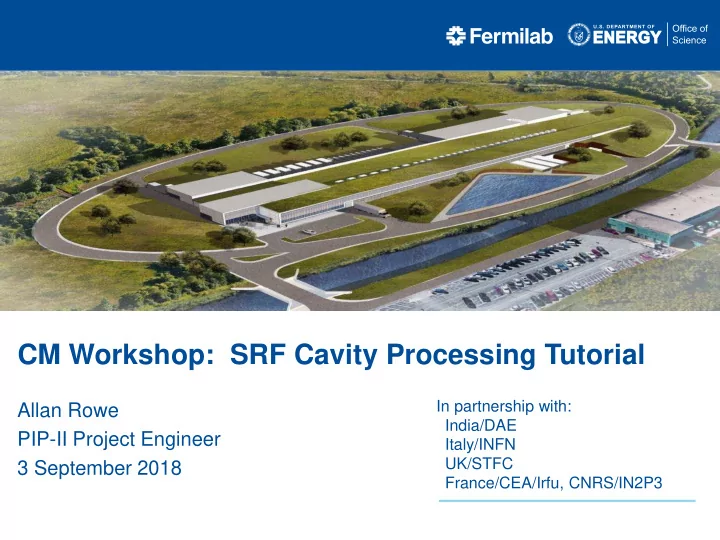

CM Workshop: SRF Cavity Processing Tutorial In partnership with: Allan Rowe India/DAE PIP-II Project Engineer Italy/INFN UK/STFC 3 September 2018 France/CEA/Irfu, CNRS/IN2P3
Outline • Intro/Bio • What is SRF cavity processing? • Processing steps and functions
Introduction/Biography • Current – PIP-II Project Engineer • Past – L2 Manager for PIP-II SRF Systems – L3 Manager for PIP-II 650 MHz Sub-system – Deputy Dept. Head of SRF Department – Group Leader for SRF Cavity Processing and Facilities – …. 3
What is SRF cavity processing? • Steps required to prepare the inner conductive layer of a Superconducting radio frequency (SRF) resonator to enable very high electric and magnetic surface fields while achieving very low surface resistance and minimal field emission. Main processing requirements: • Damaged layer removal via chemical etching or polishing. • Hydrogen degasification via high-temperature vacuum heat treatment. • Particulate and surface residue removal via ultra-clean high- pressure water rinsing. • Evacuation. • Surface water removal and surface oxide modification via low- temperature vacuum heat treatment. 4
From sheet metal to SC particle accelerator. Cavity Processing & Qualification 5
6
7
Bulk Chemistry – Buffered Chemical Polishing • Damaged layer removal caused by manufacturing – Requires 120-200 um material removal from the RF carrying surface • Two primary techniques: BCP and EP – Buffered Chemical Polishing (BCP) – an etching process • Oxidation – Reduction cycle • 1:1:2 Ratio - 48.5% HF : 70% HNO 3 : 85% H 3 PO 4 • Reaction surface temperature controlled: 12-15C • Best for asymmetrical/complex cavity geometry + lower gradient and quality factor requirements • Relatively simple process setup • Extremely hazardous due to HF and noxious fumes 8
BCP – Bare cavity setup • Exterior surface temp control • BCP solution is chilled to < 5C • Gravity filled and dumped • Pneumatic pumps slowly circulate solution • Agitation via flows tailored to resonator geometry • Ultrapure water rinsing following etching to remove residual salts • Transfer to cleanroom while surfaces are still wet 9
Jacketed SSR1 BCP Setup • Reaction temperature and fluid flows are carefully controlled 10
Bulk and Fine Chemistry: Electropolishing • Damaged layer removal + light polishing for surface optimization. • Much more complex than BCP. • Ideal for azimuthally symmetrical resonators like elliptical structures. • Can be implemented if considered during the cavity design phase. • Generally required for gradients > 25 MV/m. • Required for very high Q0 applications (N2 doping recipes). • Tight process controls essential to achieving high quality surface polishing results. • Process extremely hazardous due to HF 11
Electropolishing Principals • 10:1 Volumetric Ratio of 96% H2SO4 : 49% HF (other ratios exist) Anthony C. Crawford https://www.sciencedirect.com/science/article/pii/S0168900217300086 H. Diepers, O. Schmidt, H. Martens, F. Sun, A new method of electropolishing niobium, Phys. Lett. 37A (2) (1971) 139 12
Electropolishing Facility at Argonne Nat’l Lab 13
Electropolishing Tool Interface 14
Commercial-style Electropolishing Facility 15
ILC/XFEL/LCLS-II Bare Cavity Electropolishing External water cooling, in particular at the irises, is used to control material removal rates and reduce polishing depth ratios between the irises and equators. 16
ILC/XFEL/LCLS-II Jacketed Cavity Electropolishing • Helium vessel used as cooling jacket. • Modest removal amounts (5-15 um) acceptable up to the field flatness requirement limits. 17
650 MHz Electropolishing 18
Draining electrolyte + rinsing • After EP, the cavity is rinsed several times with ultra-pure water to remove chemical salts. 19
Centrifugal Barrel Polishing IB4 High centrifugal barrel polishing tool repairs 1.3 GHz inner surfaces when defects appear. Two 9-cell 1.3 GHz cavities can be tumbled simultaneously. 20
Centrifugal Barrel Polishing • Implemented for Elliptical cavities • Primarily used to repair large defects in welds/HAZ • Can be used as a bulk chemistry replacement • Requires EP to remove residual contamination left by CBP media Defect after EP Cutting and Polishing Media No defect after CPB + EP 21
Hydrogen Degasification IB4 High temperature vacuum furnace being loaded with a 1.3 GHz 9 cell cavity. The maximum operating temperature is 1200 C and the base vacuum is 10 -8 Torr. High temperature furnaces are used to degas and dope cavities. 22
Hydrogen Degas and N2 Doping Cycle 23
Low Temperature Baking • Low temperature (<300C) ovens use hot-air circulation to heat cavities. • UHV system maintains cavity vacuum and prevents particle migration. • Used to mitigate multipacting and correct high-field Q-slope. 24
48 hour 120C Bake Cycle Residual water removal Before/after 120C RGA spectrum 25
High-pressure Rinsing (HPR) Basic Parameters • ISO Class 4 Cleanroom • 100 ATM Pressure • 8-20 L/min • Ultrapure water • Semi-conductor quality • >18 MOhm • 0.05 um filtration • < 10 ppb TOC • 8-24 hour rinse cycles • 10-30 sec. integrated dwell times • Fan-jet or circular orifice nozzles • All wetted materials SRF compatible. 650 MHz HPR nozzle 26
Spoke Cavity High Pressure Rinsing • Multiple rinse passes and orientations • Complex geometry requires caution Horizontal orientation Vertical orientation 27
650 MHz Elliptical Cavity High Pressure Rinsing Cavity in top position Cavity in bottom position 28
Cleanroom Assembly Requirements • ISO Class 4 or better environment • High-level technical skills • Patience • Precise process controls • Component preparation • Assembly planning • Clear rejection criteria • Work-location monitoring • Component compatibility • CR environment • SRF use • Ease of assembly • Slow evacuation • Culture of SRF Technology 29
Optical Inspection Setup 30
Optical Inspection Purpose • Used as diagnostic • Defect identification • Repair technique guide • Surface feature historical Defect tracking • Optimized for elliptical cavities Confirmed repair 31
End Game Specification * n string Cavities 32
The Reward – A high-performance cryomodule! 33
Recommend
More recommend